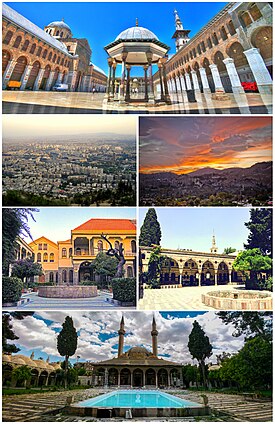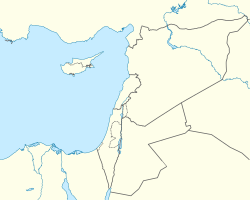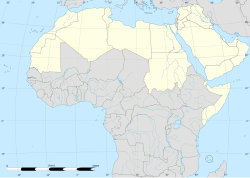Damascus
Damascus
| |
|---|---|
 | |
 Flag  Seal | |
| Nicknames: | |
 Damascus Location of Damascus within Syria | |
| Coordinates: 33°30′47″N 36°17′31″E / 33.51306°N 36.29194°ECoordinates: 33°30′47″N 36°17′31″E / 33.51306°N 36.29194°E | |
| Country | |
| Governorates | Damascus Governorate, Capital City |
| Area | |
| • Capital | 105 km2 (41 sq mi) |
| • Urban | 77 km2 (29.73 sq mi) |
| Elevation | 680 m (2,230 ft) |
| Population (2019 estimate) | |
| • Capital | 2,079,000[5] |
| • Urban | 2.90 million |
| Demonyms | English: Damascene Arabic: دمشقي, romanized: Dimashqi |
| Time zone | UTC+2 (EET) |
| • Summer (DST) | UTC+3 (EEST) |
| Area code(s) | Country code: 963, City code: 11 |
| Geocode | C1001 |
| Climate | BWk |
| HDI (2011) | 0.709[7] – high |
| Website | www |
| Official name | Ancient City of Damascus |
| Type | Cultural |
| Criteria | i, ii, iii, iv, vi |
| Designated | 1979 (3rd session) |
| Reference no. | 20 |
| State Party | Syria |
| Region | Arab States |
Damascus (/dəˈmæskəs/ də-MASS-kəs; Arabic: دمشق, romanized: Dimašq [diˈmaʃq], Syrian Arabic: [dɪˈmaʃʔ], Classical Syriac: ܕܰܪܡܣܘܩ, romanized: Darmswq)[1] is the capital of Syria, the oldest capital in the world and the fourth holiest city in Islam.[8][9][10] It became the country's largest city, following the Syrian Civil War, surpassing the northern city of Aleppo.[2]
It is colloquially known in Syria as aš-Šām (الشَّام) and titled the "City of Jasmine" (مَدِينَةُ الْيَاسْمِينِ Madīnat al-Yāsmīn).[2] Damascus is a major cultural center of the Levant and the Arab world. The city had an estimated population of 2,079,000 in 2019.
In southwestern Syria, Damascus is the center of a large metropolitan area. Its population in 2004 was estimated to be 2.7 million people.[11] Embedded on the eastern foothills of the Anti-Lebanon mountain range 80 kilometres (50 mi) inland from the eastern shore of the Mediterranean on a plateau 680 metres (2,230 ft) above sea level, Damascus experiences a dry climate because of the rain shadow effect. The Barada River flows through Damascus.
Damascus is one of the oldest continuously inhabited cities in the world.[12] First settled in the second millennium BC, it was chosen as the capital of the Umayyad Caliphate from 661 to 750. After the victory of the Abbasid dynasty, the seat of Islamic power was moved to Baghdad. Damascus saw its importance decline throughout the Abbasid era, only to regain significant importance in the Ayyubid and Mamluk periods. Today, it is the seat of the central government. As of September 2019, eight years into the Syrian Civil War, Damascus was named the least livable city out of 140 global cities in the Global Liveability Ranking.[13]
Names and etymology
| |||||||||||
| tjmsḳw[14] | |||||||||||
|---|---|---|---|---|---|---|---|---|---|---|---|
| Era: New Kingdom (1550–1069 BC) | |||||||||||
| Egyptian hieroglyphs |
The name of Damascus first appeared in the geographical list of Thutmose III as T-m-ś-q in the 15th century BC.[15] The etymology of the ancient name "T-m-ś-q" is uncertain. It is attested as


